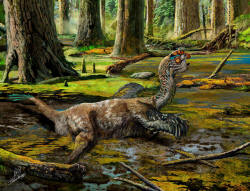|
 'Mud
Dragon' fossil shows dinosaurs thrived on eve of
destruction 'Mud
Dragon' fossil shows dinosaurs thrived on eve of
destruction
 Send a link to a friend
Send a link to a friend
[November 11, 2016]
By Will Dunham
WASHINGTON (Reuters) - In a
humid, tropical jungle in southern China eons ago, a
remarkably bird-like dinosaur with wing-like arms, a
toothless beak and a dome-shaped crest atop its head
became trapped in mud, struggled in vain to escape and
died.
|
|
 Workmen blasting bedrock while building a school near the
city of Ganzhou unearthed a beautifully preserved fossil of the
roughly 6.5-foot-long (2-meter-long) dinosaur, nicknamed the
"Mud Dragon," still in that contorted position, scientists said
on Thursday. Workmen blasting bedrock while building a school near the
city of Ganzhou unearthed a beautifully preserved fossil of the
roughly 6.5-foot-long (2-meter-long) dinosaur, nicknamed the
"Mud Dragon," still in that contorted position, scientists said
on Thursday.
The Cretaceous Period creature, called Tongtianlong limosus,
lived 66 to 72 million years ago, at the twilight of the
dinosaurs' more than 160-million-year reign on Earth. It was a
member of a group called oviraptorosaurs, one of the closest
relatives to birds, which evolved earlier from small, feathered
dinosaurs.
Paleontologist Steve Brusatte of Scotland's University of
Edinburgh, who worked on the study published in the journal
Scientific Reports, said the fossil adds to the understanding of
dinosaur evolution on the eve of destruction.

The discovery of Tongtianlong and five other oviraptorosaur
species in southern China showed this group was still blossoming
and diversifying during the last few million years before an
asteroid struck Earth about 66 million years ago, wiping out the
dinosaurs, Brusatte said.
"The fact there were so many of them is a testament to just how
well the dinosaurs were doing right up until the end," Brusatte
added.
The fossil preserved a tragic moment for posterity.
"Its neck is arched, its head sticking up, its arms
out-stretched to the sides. It is a strange posture," Brusatte
said.
[to top of second column] |

The fact that the fossil was found in rock formed from mud and the
skeleton is in pristine condition suggests the dinosaur got mired in
mud, tried to get free, but died and was buried, Brusatte said. Its
scientific name means "muddy dragon on the road to heaven," paying
homage to how it perished.
Other previous dramatic fossil finds include Mongolia's famous
"fighting dinosaurs," a Velociraptor and Protoceratops apparently
locked in mortal combat when a sand dune collapsed on them.
Tongtianlong was a two-legged omnivore, with a bony crest on its
short, squat skull that was probably used for display purposes to
attract mates and intimidate rivals. Its arms likely had quill-like
feathers layered over each other like on a wing, though it could not
fly.
"If you saw the 'Mud Dragon' alive, you probably would have said,
'That's a big, funny-looking bird,'" Brusatte said.
(Reporting by Will Dunham; Editing by Sandra Maler)
[© 2016 Thomson Reuters. All rights
reserved.] Copyright 2016 Reuters. All rights reserved. This material may not be published,
broadcast, rewritten or redistributed.
 |